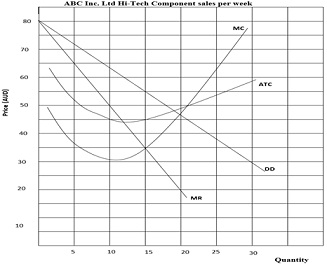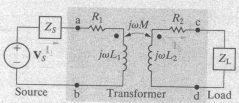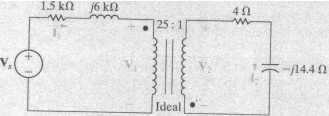Reference no: EM131259181
The next problem(s) addresses the following course learning objective(s):
- Understand the dot convention for magnetically coupled circuits.
- Analyze magnetically coupled circuits.
1. Problem 1. (The circuit of Example of 6.6 is shown below as well)
a) Write a set of mesh-current equations for the circuit in Example 6.6 if the dot on the 4 H inductor is at the right-hand terminal. the reference direction of ig is reversed, and the 60Ω resistor is increased to 780Ω.
h) Verify that if there is no energy stored in the circuit at t = 0, and if ig = 1.96 - 1.96e-41 A, the solutions to the differential equations derived in (a) of this Assessment Problem are
i1 = -0.4 - 11.6e-4t + 12e-5t A.
i2 = -0.01 - 0.99e-4t + e-5t A.

2. Problem 2
Two magnetically coupled coils have self-inductances of 52 mH and 13 mH, respectively. The mutual induc¬tance between the coils is 19.5 mH.
a) What is the coefficient of coupling?
b) For these two coils, what is the largest value that M can have?
c) Assume that the physical structure of these cou-pled coils is such that ρ1 = ρ2. What is the turns ratio N1/N2 if N1 is the number of turns on the 52 mH coil?
3. Problem 3
The self-inductances of the coils in Fig. 6.30 given below are L1 = 25 [mH] and L2 = 100 [mH]. If the coefficient of coupling is 1.0, then do the following problems.
a) If i1 equals 10 A, what value of i2 results in zero stored energy?
b) Is there any physically realizable value of i2 that can make the stored energy negative?

Figure 6.30 The circuit used to derive the basic energy relationships.
The next problem(s) addresses the following course learning objective(s):
- Understand linear transformer and ideal transformer.
- Analyze transformer circuits.
4. Problem 4
A linear transformer couples a load consisting of a 360 Ω resistor in series with a 0.25 H inductor to a sinusoidal voltage source, as shown. The voltage source has an internal impedance of 184 + J0 Ω ft and a maximum voltage of 245.20 V, and it is operating at 800 rad/s. The transformer parameters are R1 = 100 it, L1 = 0.5 H, R2 = 40 Ω, L2 = 0.125 H, and k = 0.4. Calculate (a) the reflected impedance; (b) the primary current; and (c) the secondary current.

5. Problem 5
The source voltage in the phasor domain circuit in the accompanying figure is 25∠0o kV. Find the amplitude and phase angle of V2 and I2.

6. Problem 6
a) Find the steady-state expressions for the cut rents ig and iL in the circuit in Fig. P9.72 which vg = 200 cos 10,000t V.
b) Find the coefficient of coupling.
c) Find the energy stored in the magnetically coupled coils at t = 50Π μs and t = 100Π μs

7. Problem 7
Find the impedance Zab in the circuit in Fig. P9.77 if ZL = 200 + j1.50 Ω.

Figure P9.77
|
How do structured storage systems compare to rdbms systems
: As illustrated in Figure 8-20, what is structured storage and how are structured storage systems organized? How do structured storage systems compare to RDBMS systems?
|
|
What subjects were present in your artists abstract works
: How and why did early American abstraction develop? What subjects were present in your artist's abstract works? Describe with at least one example from the artist.
|
|
Write a one page essay about urban
: Write a one page essay about "urban". Explain what is Urban (Koolhaas). Provide examples from the reading. Explain what is Urban (Garreau). Provide examples from the reading.
|
|
Find the weight of the largest fish
: The largest fish ever caught in Lake A weighed 651 pounds. This is 321.8 pounds less than eight times the weight of the largest fish ever caught in Lake B. Find the weight of the largest fish caught in Lake B.
|
|
Find the coefficient of coupling
: Find the coefficient of coupling - Find the energy stored in the magnetically coupled coils and Understand linear transformer and ideal transformer.
|
|
What flaws if any can you find in the given experiment
: Suppose a scientist observes an abnormality in the growth of robin embryos in a certain area. What flaws, if any, can you find in this experiment that might lead you to question the scientist's conclusions?
|
|
Find the population density of the country
: a. Find the population density of the country, to the nearest tenth, in 1940 AND in 2000. b. Find the percent increase in population density, to the nearest tenth of a percent, from 1940 to 2000.
|
|
Degree maclaurin polynomial
: Calculate the degree 3 MacLaurin Polynomial, P3(x), for coshx, evaluate P(1) and use the remainder term to estimate the error in using P(1) to estimate cosh(1) (to put an upper bound on the error you should use the fact that 2
|
|
Equation of the tangent line
: The equation of the tangent line at the indicated point on the graph
|